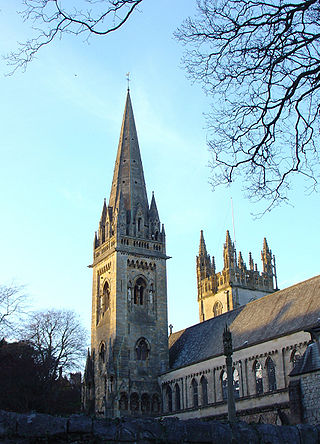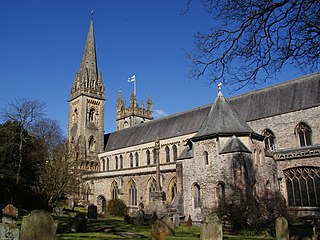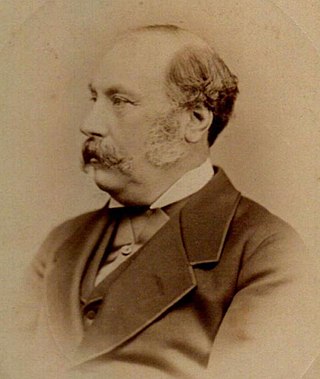
Llandaff is a district, community and coterminous electoral ward in the north of Cardiff, capital of Wales. It was incorporated into the city in 1922. It is the seat of the Bishop of Llandaff, whose diocese within the Church in Wales covers the most populous area of Wales.

Llandaff Cathedral is an Anglican cathedral and parish church in Llandaff, Cardiff, Wales. It is the seat of the Bishop of Llandaff, head of the Church in Wales Diocese of Llandaff. It is dedicated to Saint Peter and Saint Paul, and three Welsh saints: Dubricius, Teilo and Oudoceus. It is one of two cathedrals in Cardiff, the other being the Roman Catholic Cardiff Metropolitan Cathedral in the city centre.

Jasper Tudor, Duke of Bedford, was the uncle of King Henry VII of England and a leading architect of his nephew's successful accession to the throne in 1485. He was from the noble Tudor family of Penmynydd in North Wales.

William Morgan was a Welsh Bishop of Llandaff and of St Asaph, and the translator of the first version of the whole Bible into Welsh from Greek and Hebrew.

Sir Glanmor Williams was one of Wales's most eminent historians.

Gervase Babington (1549/1550–1610) was an English churchman, serving as the Bishop of Llandaff (1591–1594), Bishop of Exeter (1594–1597) and Bishop of Worcester in 1597–1610. He was a member of the Babington family and held influential offices at the same time as his cousin Anthony Babington was executed for treason against Elizabeth I as part of the Babington Plot.
Sir Robert Rees Davies, was a Welsh historian.

The Bishop of Llandaff is the ordinary of the Church in Wales Diocese of Llandaff.
Gwilym Owen Williams was a prominent figure in the Church in Wales who served as Bishop of Bangor from 1957 to 1982 and Archbishop of Wales from 1971 to 1982.

Barry Cennydd Morgan KStJ is a Welsh from Neath, Wales who, from 2003 to Jan 2017, was Archbishop of Wales. He was both Primate and Metropolitan of the Church in Wales; Morgan was the Bishop of Bangor from 1992 to 1999, and was the Bishop of Llandaff from 1999 until his retirement in January 2017. He was the longest serving archbishop in the entire Anglican Communion.
William Glyn Hughes Simon was a Welsh prelate who served as the Anglican Archbishop of Wales from 1968 to 1971.

Thomas Godwin was an English bishop, who presided over the Diocese of Bath and Wells.

Religion in Wales has, over the years, become increasingly diverse. Christianity was the religion of virtually all of the Welsh population until the late 20th century, but it has rapidly declined throughout the early 21st century. Today a plurality (46,5 %) of people in Wales follow no religion at all.
This article is about the particular significance of the year 1891 to Wales and its people.

Gregory Kenneth Cameron is a Welsh Anglican bishop. He is Bishop of the Diocese of St Asaph in Wales, having been elected on 5 January 2009 and confirmed as bishop on 16 March 2009.
Edward James was a Welsh Anglican priest and translator.
The Dictionary of Welsh Biography (DWB) is a biographical dictionary of Welsh people who have made a significant contribution to Welsh life over seventeen centuries. It was first published in 1959, and is now maintained as a free online resource.

Saint Teilo, also known by his Cornish name Eliud, was a British Christian monk, bishop, and founder of monasteries and churches. He was from Penalun (Penally) near Tenby in Pembrokeshire, south Wales.

James Harvey Insole JP was an English businessman who consolidated and developed the extensive South Wales coal mining and shipping business begun by his father George Insole.
Cyfeilliog was Bishop of Ergyng and probably Gwent in south-east Wales. He is recorded by the mid-880s in the Llandaff Charters and in 914 he was captured by the Vikings and ransomed by Edward the Elder, King of the Anglo-Saxons, for 40 pounds. He is probably the author of a cryptogram in the Juvencus Manuscript which would have required a knowledge of Latin and Greek.












